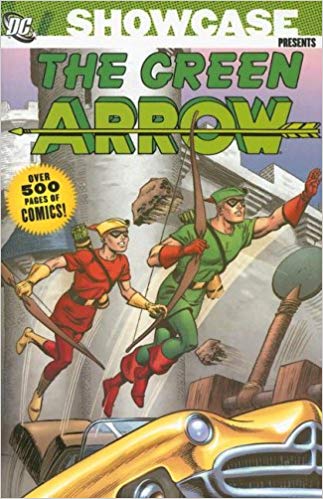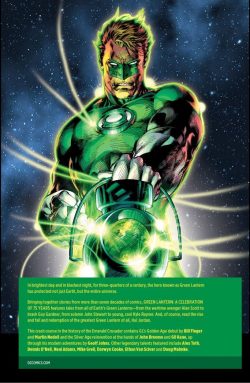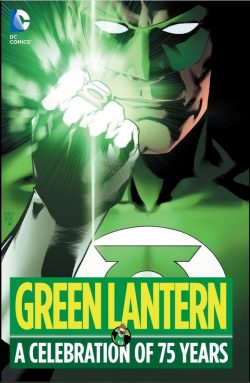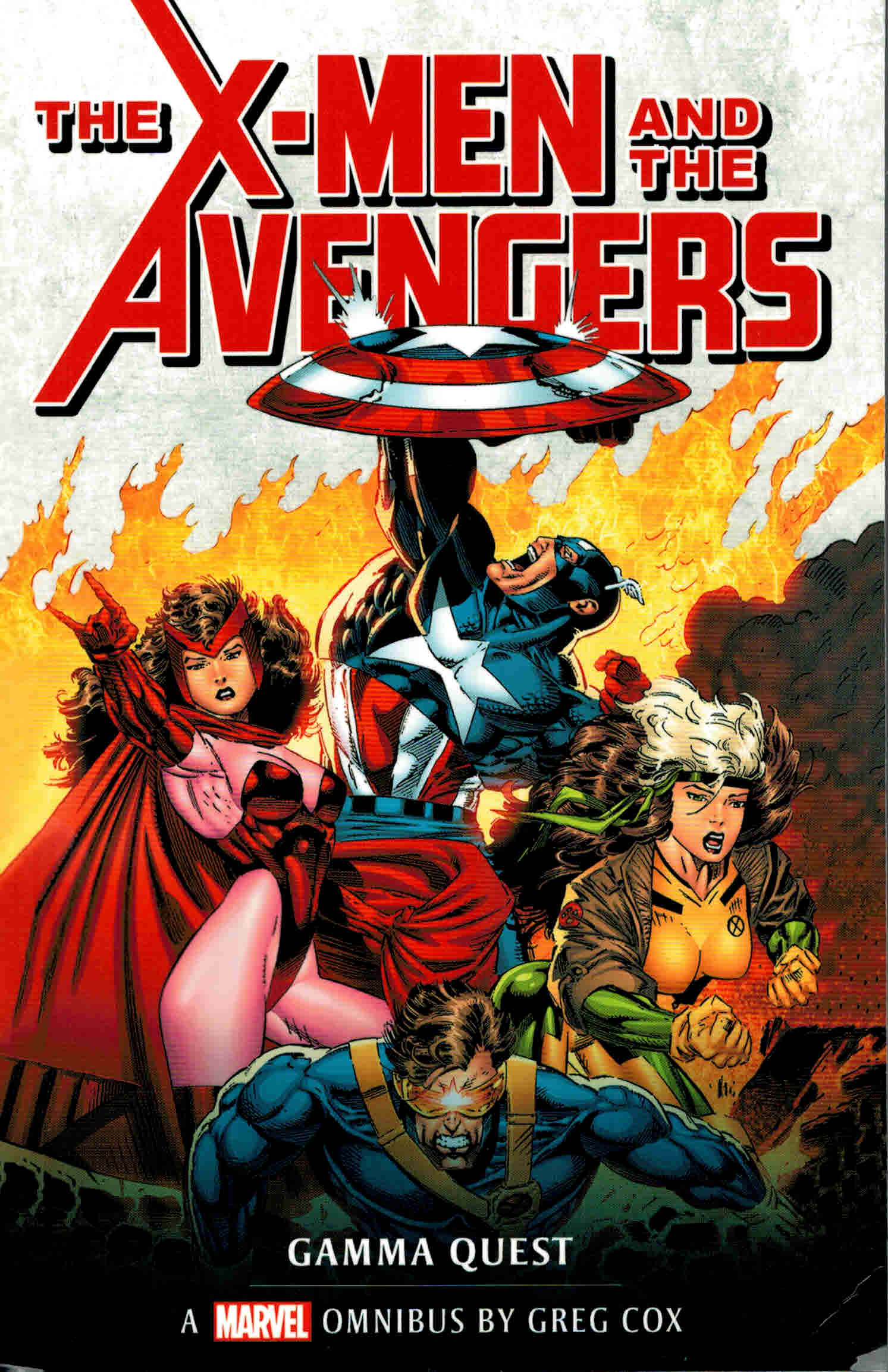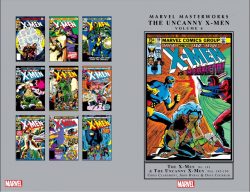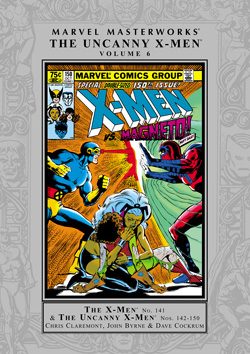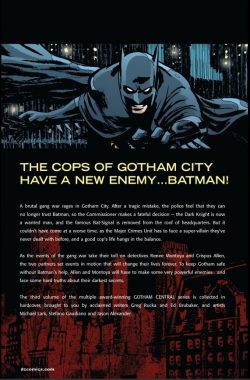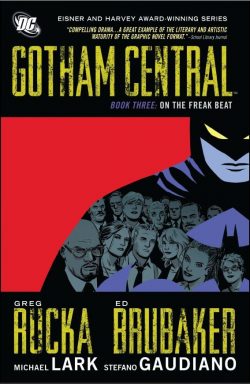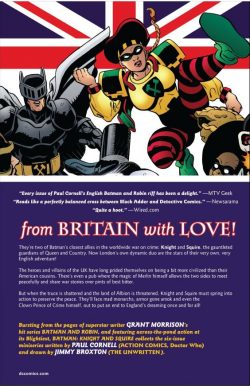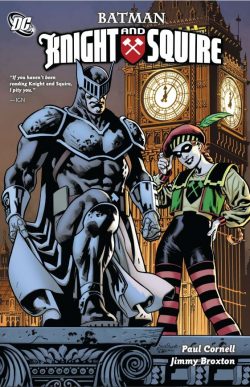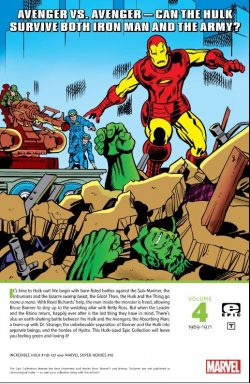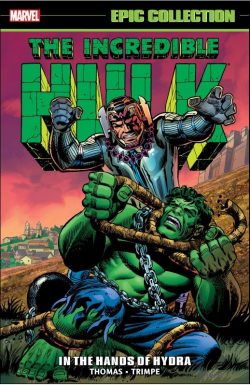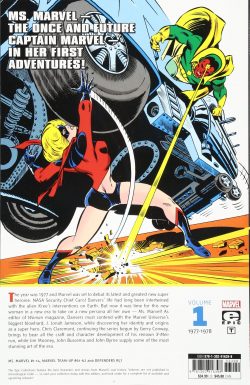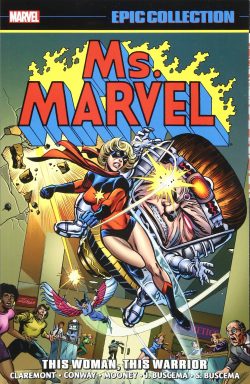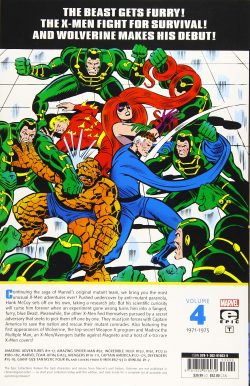
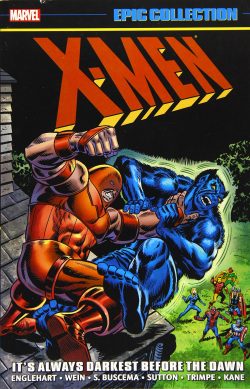
By Steve Englehart, Len Wein, Gerry Conway, Stan Lee, Roy Thomas, Archie Goodwin, Mike Friedrich, Tony Isabella, Chris Claremont, Sal Buscema, Tom Sutton, Herb Trimpe, Gil Kane, Don Heck, John Buscema, Bob Brown, Jim Starlin & various (Marvel)
ISBN: 978-1302916039 (TPB)
X-Men was never one of young Marvel’s top titles but it did secure a devout and dedicated following, with the frantic, freakish energy of Jack Kirby’s heroic dynamism comfortably transiting into the slick, sleek prettiness of Werner Roth as the blunt tension of hunted outsider kids settled into a pastiche of the college and school scenarios so familiar to the students who were the series’ main audience.
The core team consisted of tragic Scott Summers/Cyclops, telepath and mind-reader Jean Grey/Marvel Girl, wealthy golden boy Warren Worthington/Angel, ebullient Bobby Drake/Iceman, and erudite, brutish genius Henry McCoy/Beast in training with Professor Charles Xavier, a wheelchair-bound (and temporarily deceased) telepath dedicated to brokering peace and integration between the masses of humanity and the gradually emerging race of mutant Homo Superior. In latter days they had been joined by magnetic Polaris and cosmic ray fuelled Havoc… although they were usually referred to as Lorna Dane and Alex Summers.
However, by the time of this massive full-colour paperback and digital tome (collecting the covers from reprint issues X-Men #67-93 plus Annual #1-2, Amazing Adventures #11-17, Amazing Spider-Man #92, Incredible Hulk #150, 161, 172, 180-182, Marvel Team-Up #4, 23, Avengers #110-111, Captain America #172-175, Defenders #15-16 and Giant-Size Fantastic Four #4: spanning December 1970 through June 1975 and chronologically re-presenting every mutant appearance of the era) the outcasts had been reduced to reliving past glories and riding the guest star circuit. A one-shot entitled Giant-Sized X-Men #1 would soon change all that forever…
After nearly eight years of eccentrically spectacular adventures the mutant misfits virtually disappeared at the beginning of 1970 during another periodic downturn in superhero comics sales. Just as in the closing years of the 1940s, mystery men faded away as supernatural mysteries and traditional genre themes once more dominated the world’s entertainment fields…
Although gone, the mutants were far from forgotten. The standard policy at that time to revive characters that had fallen was to pile on guest-shots and reprints. X-Men #67 (December 1970) saw them return in double-sized issues, re-presenting early classics beginning with the Juggernaut tale from #12-13. Although returned as a cheap but shelf-monopolising reprint vehicle, the missing Children of the Atom were reduced to bit-players throughout the ongoing Marvel universe, whilst the bludgeoning Beast was opportunistically transformed into a scary monster to cash in on the horror boom and ultimately a comedy foil in the Avengers.
Then, with sales of the spooky stuff subsequently waning in 1975, Marvel Editor-in-Chief Roy Thomas green-lighted a bold one-shot as part of the company’s line of Giant-Size specials and history was made…
A brace of covers – X-Men Annual #1 by Jack Kirby & Chic Stone and X-Men #67 by Marie Severin & Joe Sinnott – lead us to John Romita’s cover for Amazing Spider-Man #92 (January 1971) and a tale by Stan Lee, Gil Kane & Romita depicting ‘When Iceman Attacks’.
This actually concludes the Amazing Arachnid’s battle against corrupt political boss Sam Bullit, as the ambitious demagogue convinces the youngest X-Man that Spider-Man is a kidnapper. Despite being a closing chapter, this all-out action extravaganza efficiently recaps itself and is perfectly comprehensible to readers.
The covers to X-Men #68-74 (by Kirby, Dick Ayers, Sal Buscema, Werner Roth, Bill Everett & Kane) and King Size Annual #2 (Kane & Romita) further celebrate the individual and collective Merry Mutants comeback tour before the next story opens.
Alec Summers had left the X-Men, terrified of his uncontrollable cosmic power, to isolate himself in the deserts of New Mexico. When Lorna Dane goes looking for him in ‘Cry Hulk, Cry Havok!’ (Incredible Hulk #150 April 1972, Archie Goodwin, Herb Trimpe & John Severin) she encounters a menacing biker gang and an Emerald Giant violently protective of his privacy. Mercifully Havok proves a match for the rampaging titan…
The previous month Marvel had launched a reinvented X-Man in a solo series as a response to the world horror boom which shifted general comic book fare from bright shiny costumed heroes to dark and sinister monsters.
Premiering in Amazing Adventures #11 (March 1972), written by Gerry Conway and illustrated by the incredibly effective team of Tom Sutton & Syd Shores, ‘The Beast!’ reveals how brilliant Hank McCoy leaves Xavier’s school and takes a research position at the conglomerate Brand Corporation.
Using private sector resources to research the causes of genetic mutation, McCoy becomes embroiled in industrial skulduggery and – to hide his identity – uses his discoveries to “upgrade” his animalistic abilities – temporarily turning himself into a fearsome anthropoid creature with startling new abilities. At least it was supposed to be temporary…
Bracketed by Kane & Frank Giacoia’s covers for X-Men #75-76, Steve Englehart assumes the writing reins in AmazingAdventures #12 (May), and monster maestro Mike Ploog takes the inker’s chair for ‘Iron Man: D.O.A.’ as McCoy, trapped in a monstrous new shape, took extreme measures to appear human as he desperately strove to find a cure for his condition. Unfortunately, Brand is riddled with bad characters and when Tony Stark visits, it’s inevitable that the Beast and Iron Man clash…
Incomprehensibly that battle led to Iron Man’s death; or so McCoy thought. In fact, the monster has been mesmerized by villainous Mastermind in a scheme to force the outcast to join the Brotherhood of Evil Mutants. ‘Evil is All in Your Mind!’(Englehart, Sutton & Giacoia) also reintroduces two characters from the wildest fringes of Early Marvel continuity who will both play major roles in months and years to come. Patsy Walker was an ideal girl-next-door whose wholesome teen-comedy exploits had delighted readers for decades since her debut in Miss America #2 (Nov. 1944).
She starred in seven separate comic series until 1967. Here she joins the cast of the Beast as the tag-along wife of her boyhood sweetheart Buzz Baxter who had grown from an appealing goof to a rather daunting military martinet and Pentagon liaison. As McCoy is throwing off the defeated mesmerist’s psychic influence, Captain Baxter lays plans to capture the maligned mutate…
George Tuska & Vince Colletta’s cover for X-Men #77 precedes the next full story, proving the other X-Men were not forgotten. New Horror-Hero rising star Morbius, the Living Vampire was making things tough for Spider-Man in Marvel Team-Up #4 (September 1972) as the Human Torch temporarily bows out to be replaced by the mutant team. ‘And Then… the X-Men!’ is a terse, tense thriller written by Conway, inked by Steve Mitchell and illustrated by the magnificent Gil Kane at the top of his form detailing how the outsiders hunt the sanguine predator in search of a cure for as the ailing arachnoid…
Bloodsuckers literal and metaphorical are also the order of the day in Amazing Adventures #14. ‘The Vampire Machine’ (inked by Jim Mooney) sees Iron Man return as computerized killer and incipient AI assassin Quasimodo attacks Brand Corp. in an attempt to steal radical technology to build himself a body…
Kane & Giacoia’s cover for X-Men #78 precedes AA #15’s ‘Murder in Mid-Air!’ (rendered by Sutton, Giacoia & John Tartaglione) finding a gravely wounded Beast making an unexpected ally and confidante, before old comrade the Angel comes calling, encountering a hideous artificially mutated monster dubbed the Griffin en route. This tale reintroduced another old friend of Hank McCoy’s and should segue into another X-crossover (Incredible Hulk #161, March 1973), but not before the cover of X-Men #79 and 80 intermingle with AA #16 – wherein our hirsute hero battles an old foe in the Halloween thriller ‘…And the Juggernaut Will Get You… If You Don’t Watch Out!’ by Englehart, Bob Brown & Frank McLaughlin, with a horde of classic caricatures from cartoon legend Marie Severin.
It was the last time McCoy would be seen in a full tale until the bombastic Beast joined the Avengers. Amazing Adventures #17 featured a 2-page framing sequence by Englehart, Jim Starlin & Mike Esposito (included here) which bracketed an abridged reprint of the Beast origin back-ups from X-Men #49-53 (which are not).
At last that Hulk hiatus ends as ‘Beyond the Border Lurks Death!’ (Englehart, Trimpe & Sal Trapani) sees the Green Goliath and Bouncing Blue Beast as reluctant allies in a battle against old X-foe the Mimic, whose ability to absorb the attributes of others has gone tragically, catastrophically haywire…
X-Men #81’s cover leads to another titanic team-up – from Avengers #110-111 (April and May 1973) – as Captain America, Thor, Iron Man, Scarlet Witch, Vision and Black Panther investigate the disappearance of the mutant heroes and are thoroughly beaten by their oldest enemy sporting a new power.
‘… And Now Magneto!’ (Englehart, Don Heck, Giacoia & Esposito) ends with half the team brainwashed captives of the master villain with the remaining crusaders desperately searching for new allies.
Not included here is their journey to San Francisco to recruit Daredevil and the Black Widow so the saga resumes and concludes in Avengers #111 as, ‘With Two Beside Them!’ (Englehart, Heck & Esposito) the returned heroes and West Coast vigilantes successfully rescue the X-Men and Avengers enslaved by the malign Magneto…
With X-Men #82 (June), the covers generally reverted to recoloured and modified versions of the original releases: rendered by Dan Adkins, Ross Andru, Heck, Tuska & Giacoia, bringing us to February 1974 and Incredible Hulk #172.
A Roy Thomas plot and Tony Isabella script sees the Gamma Giant captured by US soldiers and hurled into another dimension, allowing the unstoppable mystic menace to inadvertently escape. ‘And Canst Thou Slay… The Juggernaut?’ reveals that even his magically augmented might cannot resist our favourite antihero and features a telling, conclusive cameo by Cyclops, Marvel Girl and Professor X, after which the Tuska cover for X-Men #87 precedes a crucial episode in the lives of the mutant adventurers.
Englehart was at this time making history with an allegorical saga in Captain America and the Falcon mirroring the national scandal of President Nixon and Watergate. The Patriotic Paragon found himself framed for murder and smeared by a media disinformation campaign and forced to go on the run to clear himself.
Brought to you by Englehart, Sal Buscema & Vince Colletta, it begins in Captain America #172 as ‘Believe it or Not: The Banshee!’ finds Cap and the Falcon tracing a lead to Nashville, clashing with the eponymous fugitive mutant and stumbling into a clandestine pogrom on American soil…
For months mutants have been disappearing unnoticed, but now the last remaining – Cyclops, Marvel Girl and Charles Xavier – have tracked them down, only to discover that Captain America’s problems also stem from ‘The Sins of the Secret Empire!’ whose ultimate goal is the conquest of the USA…
Eluding capture by S.H.I.E.L.D., Steve and Sam infiltrate the evil Empire, only to be exposed and confined in ‘It’s Always Darkest!’ before abruptly turning the tables and saving the day in #175’s ‘…Before the Dawn!’ (interrupted only by the cover for X-Men #88) wherein the vile grand plan is revealed, the mutants liberated and the culprits captured. In a shocking final scene, the ultimate instigator is unmasked and horrifically dispatched within the White House itself…
Marvel Team-Up #23 (July 1974, by Len Wein, Kane & Esposito) offers a case of mistaken identity – and powers – before Human Torch Johnny Storm and Iceman fractiously unite to stop Equinox, the Thermo-Dynamic Man on ‘The Night of the Frozen Inferno!’ after which Ed Hannigan & Giacoia’s cover for X-Men #89 carries us to Defenders #15 (September), which initiates a 2-part duel with Magneto who first institutes a ‘Panic Beneath the Earth!’ – courtesy of Wein, Sal Buscema & Klaus Janson – leading telepath Charles Xavier to enlist the outcast heroes’ (Dr. Strange, Nighthawk, Valkyrie and Hulk) aid. The concluding clash involves the insidious Brotherhood of Evil Mutants and ‘Alpha, the Ultimate Mutant’ (inked by Esposito) as well as the apparent end of a true master of evil…
The same cover-month that X-Men #90 (by John Buscema) was released, a pivotal X-character made a rather inauspicious debut.
Incredible Hulk #180 (October 1974 by Wein, Trimpe & Jack Abel) declares ‘And the Wind Howls… Wendigo!’ as the Green Giant gallivants across the Canadian Border and encounters a witch attempting to cure her brother of a curse which has transformed him into a rampaging cannibalistic monster. Unfortunately, that cure means Hulk must become a Wendigoin his stead…
It is while the Great Green and Weird White monsters are fighting that mutant megastar Wolverine first appears – in the very last panel – leading to the savage fist, fang and claw fest that follows.
‘And Now… The Wolverine!’ captivatingly concludes the saga as the Maple nation’s top-secret super-agent is unleashed upon both the Emerald Goliath and man-eating Wendigo in an action-stuffed romp teeming with triumph, tragedy and lots of slashing and hitting. The rest is history…
The aftermath spilled over into #182’s ‘Between Hammer and Anvil!’ with Trimpe taking sole charge of the art chores for the two pages included here as Wolverine is called off by his Canadian spymasters…
John Buscema & Tuska’s cover for X-Men #91 then leads to the last story in this colossal compendium as in Giant-Size Fantastic Four #4 Wein, Chris Claremont, John Buscema, Chic Stone & Joe Sinnott unite to introduce ‘Madrox the Multiple Man’: a young mutant who grew up on an isolated farm unaware of the incredible power he possesses.
When his parents pass away, the kid is inexplicably drawn to New York City, but the mysterious hi-tech suit he wears to contain his condition soon malfunctions and the boy devolves into a ambulatory fission device who can endlessly, lethally replicate himself…
Thankfully the FF are aided by mutant Moses Charles Xavier who dutifully takes young Jamie under his wing…
Concluding with the covers to X-Men #92 and 93 (by Ron Wilson & Giacoia and John B & Tuska), house ads and the wraparound October 1986 cover to one-shot The Incredible Hulk and Wolverine #1 – by John Byrne & Abel – this massive meander into Marvel mutant minutiae is a little scrappy and none too cohesive but is packed to the brim with wonderful comics sagas and groundbreaking mini-masterpieces which reshaped the way we tell stories to this day. This comprehensive collection is an unquestionable treasure no fan should be without.
© 2019 MARVEL

